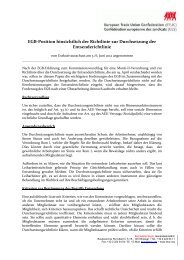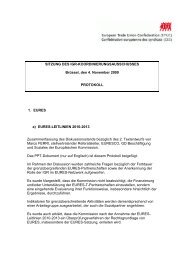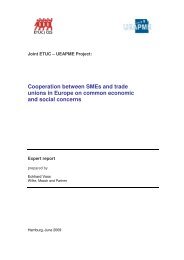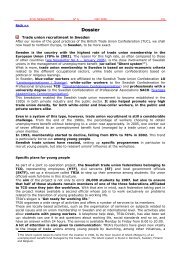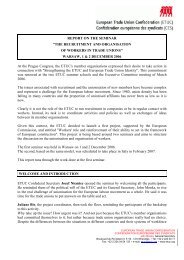Structural reforms and macro-economic policy - ETUC
Structural reforms and macro-economic policy - ETUC
Structural reforms and macro-economic policy - ETUC
You also want an ePaper? Increase the reach of your titles
YUMPU automatically turns print PDFs into web optimized ePapers that Google loves.
3. From 1997 to 2005: the SGP undergoes<br />
reform<br />
3.1. Eight years, twelve sinners<br />
From 1997 to 2000 robust growth <strong>and</strong> declining<br />
interest rates, together with a small positive fiscal<br />
impulse (0.3% of GDP per year according to the OECD,<br />
see Table 2), allowed public deficits to fall in the euro<br />
area. Public deficits started to rise again in 2001-2002<br />
because of decelerating <strong>economic</strong> activity <strong>and</strong><br />
because the fiscal impulse still remained slightly<br />
positive. Despite the repeated requests of the<br />
Commission, the euro area’s primary structural<br />
surplus decreased over the 1997-2002 period.<br />
Table 2: General government balances in the euro area<br />
Percentage of GDP<br />
government<br />
balance<br />
Cyclical component<br />
Interest payments<br />
Cyclically-adjusted<br />
primary balance<br />
1997 -2.6 -0.7 4.5 2.5<br />
1998 -2.3 -0.3 4.2 2.2<br />
1999 -1.3 -0.0 3.6 2.3<br />
2000 -1.0 0.7 3.6 1.7<br />
2001 -1.9 0.6 3.5 0.8<br />
2002 -2.5 0.0 3.3 0.5<br />
2003 -3.0 -0.6 3.1 0.4<br />
2004 -2.7 -0.7 2.9 0.5<br />
2005 -2.9 -1.0 2.8 0.5<br />
(1) Excluding proceeds from the sale of UMTS licences.<br />
Source: OECD (2005).<br />
Since the <strong>economic</strong> slowdown of 2001, the SGP has<br />
generated permanent tensions in Europe. The<br />
Commission has been asking for cuts in public deficits<br />
even as Member States try to support growth in a situation<br />
of high unemployment <strong>and</strong> weak inflation. The<br />
crisis erupted in November 2003 when the Council<br />
refused to adopt the Commission recommendations<br />
calling on France <strong>and</strong> Germany to strongly reduce their<br />
structural deficits in 2004 <strong>and</strong> 2005. The Council then<br />
adopted a less stringent conclusion which was accepted<br />
by the French <strong>and</strong> German governments. The<br />
Commission however was of the opinion that the<br />
Council did not have the right to refuse its recommendation;<br />
procedures <strong>and</strong> fines should be automatic. So<br />
the Commission put the case before the European<br />
Court of Justice. According to its verdict, Member States<br />
retain the right of appreciation in the excessive deficit<br />
procedure (EDP), but recommendations on excessive<br />
deficits can be modified by the Council only on the<br />
initiative of the Commission. So the Commission <strong>and</strong> a<br />
qualified majority of the Council must reach agreement.<br />
In September 2004, it came to light that the public<br />
deficit figures provided by Greece had been false since<br />
1997 <strong>and</strong> that the Greek deficit had never fallen below<br />
3% of GDP. In 2005, deficit figures for Italy <strong>and</strong> Portugal<br />
were also raised. In December 2005, 12 EU countries<br />
were su-jected to an Excessive Deficit Procedure: five in<br />
the euro area, the UK <strong>and</strong> six new Member States. In<br />
most new Member States, public deficits are higher<br />
than 3% of GDP, but public debt remains below 60% of<br />
GDP, while these countries also have significant public<br />
infrastructure needs. From 1998 to 2005, the 3% ceiling<br />
has been breached for eight years by Greece, five years<br />
by Italy, four years by France <strong>and</strong> Germany, two years by<br />
Portugal <strong>and</strong> one year by the Netherl<strong>and</strong>s.<br />
3.2. On national views<br />
Some countries, like Spain, oppose any change in the<br />
Pact. Spain benefits from robust growth thanks to low<br />
nominal interest rates as compared to domestic inflation<br />
<strong>and</strong> GDP growth, <strong>and</strong> does not need any expansionary<br />
fiscal <strong>policy</strong>. However, with inflation at 3.6%<br />
<strong>and</strong> a current account deficit at 7.4% of GDP for 2005,<br />
Spain is less virtuous than Germany, where inflation is<br />
2.0% <strong>and</strong> the current surplus 3.8% of GDP. Some small<br />
countries like the Netherl<strong>and</strong>s, Belgium <strong>and</strong> Austria use<br />
the European disciplinary framework to cut their public<br />
debts <strong>and</strong> are also opposed to a reform of the Pact.<br />
The larger countries have called for a reform of the Pact.<br />
In November 2004, Silvio Berlusconi called for a Pact<br />
oriented towards growth rather than stability. He<br />
suggested the exclusion of public capital <strong>and</strong> R&D expenditures<br />
from the deficit figures. Gerhard Schröder<br />
claimed that the judgement on excessive deficits<br />
should take account of several criteria, e.g.: the introduction<br />
of <strong>reforms</strong> that are costly in the short run but boost<br />
growth in the long term; the country’s contribution to<br />
price stability in Europe; the <strong>economic</strong> situation; the net<br />
contribution to the EU budget <strong>and</strong>, as concerns<br />
Germany, transfers to new Länder. The French government<br />
suggested the exclusion of military spending <strong>and</strong><br />
aid for developing countries.<br />
Ultimately, European cohesion was at stake in this<br />
discussion. On the one h<strong>and</strong>, the three largest countries<br />
represent 75% of the euro area population <strong>and</strong> might<br />
have vetoed a reform. On the other, several smaller<br />
countries accused Germany <strong>and</strong> France of not<br />
complying with European rules. But some of these<br />
smaller countries receive Community funds, benefited<br />
PART 3: <strong>Structural</strong> <strong>reforms</strong> <strong>and</strong> the european <strong>macro</strong>-<strong>economic</strong> <strong>policy</strong> regime<br />
/ 71






